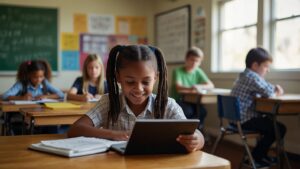The Power of Personalized Learning Strategies
As a public school teacher, I often reflect on what personalized learning strategies truly mean in the context of modern education. Imagine stepping into a classroom where the “one size fits all” approach is a thing of the past. Instead, students embark on individualized learning journeys shaped by strategies tailored to their unique strengths, skills, needs, and interests. In my classroom, I strive to implement these strategies, ensuring that every student has a pathway to success.
Personalized learning recognizes that children learn at different paces and in different ways. The ultimate goal is to ensure that all students stay on track to meet the standards required for a high school diploma. While this model isn’t yet widespread, many schools are adopting personalized learning strategies, and I am excited to see their impact growing across the nation.
What is Personalized Learning?
At its core, personalized learning relies on strategies that adapt to the individual needs of every student. This teaching model goes beyond traditional “one size fits all” methods by tailoring each learner’s experience.
Through personalized learning strategies, students receive custom learning plans based on what they already know, how they learn best, and their skills and interests. These strategies foster ownership, engagement, and confidence, allowing students to thrive academically and emotionally.
Addressing Common Concerns from Parents
Parents often express concerns about their children’s educational experience. Personalized learning strategies can help address issues such as:
- My child feels overwhelmed by school. Does this mean they have anxiety?
- How can my partner and I align our strategies to support our child with ADHD?
- What can I do to help my child learn to stay calm when things don’t go as planned?
By focusing on tailored strategies for each student, personalized learning creates a supportive framework to address these concerns. Parents can also find additional guidance through resources like the Understood Assistant, which provides expert insights into navigating learning challenges.
How Personalized Learning Strategies Work in Practice
Effective personalized learning depends on strategic approaches tailored to students’ diverse needs. Here are four key strategies commonly implemented in schools:
- Learner Profiles
These detailed records capture each student’s strengths, challenges, motivations, and goals. By maintaining dynamic and frequently updated profiles, educators can adjust teaching strategies to better support student learning. - Personalized Learning Paths
In this approach, students follow learning paths that are strategically designed to adapt to their progress and interests. For example, a weekly schedule might include collaborative projects, independent study, and targeted one-on-one sessions, ensuring students engage with content in ways that resonate with them. - Competency-Based Progression
This strategy emphasizes mastery of specific skills over traditional time-based progress. For instance, a student might demonstrate understanding by applying math concepts during a real-world internship, showcasing learning in a meaningful context. - Flexible Learning Environments
Personalized learning strategies also extend to the physical and organizational setup of schools. By reimagining classroom layouts and schedules, teachers can create environments that support collaborative work, independent study, or small-group instruction.
Bridging Gaps with Personalized Learning Strategies
When implemented effectively, personalized learning strategies can bridge critical gaps in education. They can reduce the stigma often associated with special education by emphasizing students’ strengths and interests alongside their challenges. These strategies complement Individualized Education Programs (IEPs) and Response to Intervention (RTI) plans by providing holistic, accessible, and engaging learning experiences.
Moreover, personalized strategies encourage students to develop self-advocacy skills, empowering them to communicate their needs and take an active role in their education.
Challenges and Opportunities
Despite their potential, personalized learning strategies are not without challenges. A major concern is ensuring teachers receive sufficient training to use these strategies effectively. Without proper preparation, there’s a risk that students—particularly those with learning differences—could be left behind.
Parents play a crucial role in advocating for the resources and training needed to implement these strategies successfully. When educators and families collaborate, personalized learning strategies can transform classrooms into spaces where every child thrives.
Join the Conversation
The shift toward personalized learning is more than just a trend—it’s a meaningful evolution in education. By focusing on personalized learning strategies, schools can better address diverse student needs, foster engagement, and create equitable learning opportunities. I encourage parents to explore how these strategies are being used in schools nationwide, learn about their benefits, and advocate for the resources necessary to support their implementation.
Together, we can build a future where every child learns through strategies tailored just for them.
You may also enjoy this.








